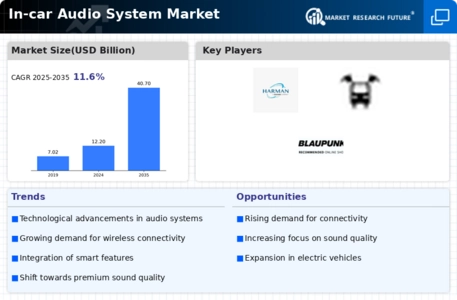Market Share
In-car Audio System Market Share Analysis
The in-car audio system market is rapidly changing, with several key shifts taking place that reshape the automotive entertainment industry. One of these trends involves incorporating advanced audio technologies into vehicles to give users an immersive sound experience. Apart from this, car audio systems are converging with other technologies due to an increase in connectivity and infotainment features on vehicles. Some of the ways through which this is achieved include integration with smartphone platforms, voice recognition, and streaming services (music, podcasts, audiobooks & live radio). This trend reflects the rising consumer demand for connected and personalized entertainment while driving. Another thing is that the audio system market is seeing an increasing focus on personalization and customization features in in-car products. Makers are now offering sound customization options, equalizer settings, and user profiles to enable travelers to customize their own audio experience. Again, the integration of intelligent systems and AI has been improving automotive audio equipment. Using artificial intelligence solutions, listening behaviors, driving conditions, and acoustic environments can be analyzed by AI algorithms for adaptive modifications of audio parameters in real-time, hence yielding the best possible sound experience. Additionally, sustainability and energy efficiency are emerging significant trends within the market for in-car audio systems. Companies tend to manufacture energy-saving sound systems with no drop in sound quality at present. Definitely, though, the use of sustainable materials and green production methods is beginning to gain momentum, coinciding with the broader commitment of the auto industry towards environmental sustainability. Moreover, electric vehicles (EVs) and autonomous vehicles (AVs) have changed how car audio systems should be designed and used. For instance, EVs have silent propulsion systems that offer both challenges and opportunities for designing audio equipment for them. They use advanced sound engineering approaches to counteract engine absence noises or reduce road noise levels and create a good auditory ambiance inside electric vehicles. Audio technology advancements such as advanced audio technologies (such as Dolby Atmos), connectivity (e.g., Bluetooth connections), personalization (for example, ability to adjust EQ settings on equalizers), decongestion (like cell phone consolidating mp3 functions), connectedness with other cars among others will help shape the future market of this product.

















Leave a Comment